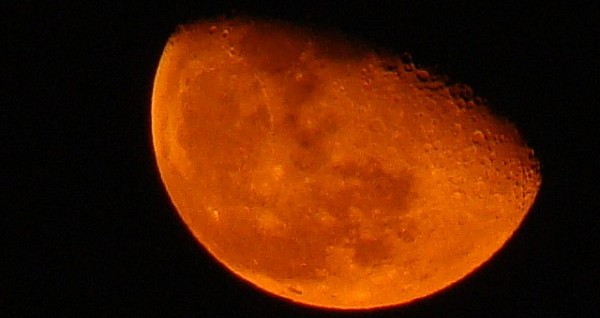
What dreamer named the landscape of the moon? There you can go to the Sea of Tranquillity. You can float on the Sea of Cold or the Sea of Rains. You can dally on the Sea of Fecundity. You can toss on the Sea of Storms.
From here, the “seas,” or maria (Latin, mare, sea), are those dark patches visible with the naked eye. They are flat and dry, ancient lava flows. Nothing oceanic about them. They were never tranquil, never rainy, never fecund, never cool. They were hot, liquid, furious. That was three billion-plus years ago. Now they are basaltic rock.
It’s not hard to learn to recognize the maria by name. Especially with binoculars but even without binoculars. The moon always faces us the same way. We never see its back side—which is not “the dark side,” since it’s often brightly lighted. Our moon is locked into synchronous rotation, meaning that it turns on its own axis exactly once per orbit around the earth.
Here in Seattle, where I live, I am looking out my south window, gazing at a full moon high in the sky, made gothic by clouds flying past. How mysterious it looks, hanging above the apple tree.
The moon has been hit and hit again by immense asteroids and by comets. It has no atmosphere to slow anything down or burn anything up. Its original crater-pocked face was created during the Era of Heavy Bombardment. This was early in the history of our solar system, 4.5 to 3.9 billion years ago, when massive rogue objects went spinning about and colliding. Imagine the hit that caused a crater 25 miles wide more than two miles deep. That’s Aristarchus. Imagine the hit that made the crater Plato, 68 miles wide.
Even more spectacular, imagine the hit that the earth took when a Mars-sized object whacked it, busted up a chunk of our planet’s surface, and blew it away. The debris from the cataclysm went into orbit and eventually coalesced into our moon. At least that’s the leading hypothesis on its origin. Evidence? The moon’s crust mimics the earth’s crust. Also the moon lacks anything easily vaporized, such as water (except maybe a bit of ice at the poles, put there by comets). The heat of the original impact blast would have vaporized any such matter, leaving the moon without.
Fast forward to the total lunar eclipse of December 2010. A full lunar eclipse happens when sun, moon, and earth line up exactly, with the earth in the middle. Then the full moon passes through the earth’s shadow. Alas, in Seattle, it was rainy and cloudy. I could see the strange moon, and then I couldn’t, and then I could. For a time during the three-and-a-half-hour eclipse I could see the earth’s curved shadow cross the moon. So yes, the earth is round. But at the moment of climax, when the moon slips altogether into the earth’s shadow and turns reddish orange, or so they say (and so photos show), my moon turned coy and slipped behind its cloud curtain. It declined to shine. I went to bed in disgust.
A shorter version of this essay was published in our Autumn 2011 issue.

